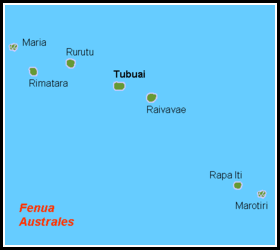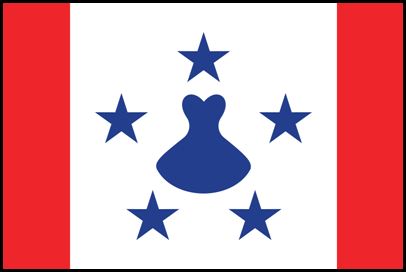Australs and Tubuai

|
The Austral Islands
 The Austral Islands
are the southernmost group of islands in French
Polynesia,
an overseas
collectivity of
France.
Geographically, they consist of two separate archipelagos, namely in the
northwest the Tubuai
Islands
consisting of the Maria,
Rimatara,
Rurutu, Tubuai Island proper and Raivavae. In
the southeast the Bass
Islands are
Rapa
and
tiny Marotiri.
Maria and Marotiri are uninhabited, as are several of the islands’
islets and rocks off their coastlines. The Austral Islands' population is about
6,300. The capital of the Austral Islands administrative subdivision is
Tubuai.
The islanders have their own unique cultural identity and speak their own
language, Tuha’a Pae. The
next region south by thousands of miles is the Antarctic, humpback whales make
the journey to hibernate in the warmer waters in July, August and September, the
winter months.
The flag of the Austral Islands.
Tubuai
Tubuai or Tupa’i in Polynesian lies three hundred and fifty miles south of Tahiti, a short flight for the few tourists who want to visit. Kite surfing in a remote location is becoming a popular draw but the experience is just for the few intrepid explorers who want to escape the crowds of other French Polynesian islands. Inhabited around the year one thousand, the three thousand natives developed a strict society dominated by religion, sacred places “mara’e dot the island and a knowledge still passed down through the generations orally, together with distinct tattoos. Samuel Wallis was the first explorer to see the island in 1767. Soon after Captain Cook visited the island on his third Pacific voyage in August 1777, the first missionaries, Protestants of the London Missionary Society arrived forty years later and set about converting the islanders. Sadly, they didn’t just bring modern religion, they brought diseases and introduced alcohol. By the late 18th century only three hundred people were left on Tubuai. In 1842 the island came under French Protectorate and was annexed in June 1880. Numbers have steadily grown and the current population is around two thousand.
Tubuai is one of the most densely populated islands of the archipelago. It is the administrative centre and therefore benefits from many facilities and services brought up by that legal status. Agriculture is the biggest earner for the island, the flat area around the coast is well suited to fertile fields of cultivation. I wanted to take a picture of the new to us taro, but our new friend at the produce shop insisted it was posed by his wife and mum. An odd looking vegetable, quite woody and a challenge to chew and digest, like a very firm yam but when boiled a greyish colour.
Potatoes are grown extensively and loaded for export, funnily enough we never saw any for sale.
One of the many ‘little shops’ we pass on our walk to the village.
Our old friend Tuhaa Pae IV came in during our visit.
Our next visit ashore we ventured to the old wharf, picking
our way through the coral heads, leaving Beez and the supply
ship behind.
We saw the locals taking down the festival
‘mall’. We entered the police station at eleven thirty, visited the
supermarket and seated outside with ice lollies fifteen minutes later.
Two days later all clean and
tidy.
Back to Beez before the rain.
No. We got
soaked.
A very dull picture in the lashing rain compared to the sunny one of this
morning.
The weather didn’t stop these hardy
annuals training. At five our friend left, but more rain clouds as she disappeared from view
.
We all remember the most famous mutiny in Naval history and the various books and films made about the Mutiny of the Bounty. We even remember the two lead characters – Fletcher Christian and Captain Bligh, so well played by Charles Laughton in 1935, Trevor Howard in 1962 and later Sir Anthony Hopkins in 1984. We don’t remember Tubuai and it’s role in the story, in fact Tubuai could so easily been home to the mutineers and not Pitcairn if things had gone better. On the 28th of April 1789 on the way back from a six month stay on Tahiti, part of the crew rebelled. Bligh was abandoned on a longboat, supported by the loyal men who respected his authority.
William Bligh in 1814, many years after the events described here In all, 18 of the loyal crew were in the launch with Bligh; 4 other loyalists were forced to stay with the 18 mutineers and 2 passive crew. The mutiny took place about 30 nautical miles from Tofua (Bligh spelled it Tofoa). Bligh and his crew attempted to land here (in a cove that they subsequently called "Murderers' Cove") to augment their meagre provisions. The only casualty during this voyage was a crewman, John Norton, who was stoned to death by some natives of Tofua. Bligh then navigated the 23-foot open launch on a 47-day voyage to Timor in the Dutch East Indies. Equipped with a quadrant and a pocket watch and with no charts or compass, he recorded the distance as 3,618 nautical miles. He was chased by cannibals in what is now known as Bligh Water, Fiji and passed through the Torres Strait along the way, landing in Kupang, Timor on the 14th of June. Shortly after the launch reached Timor, the cook and botanist died. Three other crewmen died in the coming months. Lieutenant Bligh returned to Britain and reported the mutiny to the Admiralty on the 15th of March 1790, 2 years and 11 weeks after leaving England. Fletcher Christian and the others knew if they were caught they would be hanged so they Christian chose to leave Tahiti to seek a safe haven for his fellow mutineers and the Bounty. Tubuai at that time, was seen as an isolated and less known island. H.M.S. Bounty arrived on the 24th of May 1789. The locals were hostile and during a swift battle twelve islanders were killed, their spears no match for the guns and cannons of the rebels. The battlefield is today known as Bloody Bay, just near the airport. The mutineers returned to Tahiti, but a month later thought they could overcome the natives of Tubuai and a second landing occurred on the 23rd of June 1789. They had seen for themselves just how fertile the land was and on this voyage brought food, cattle, and also gifts to try to endear the locals with. The strict society, with its hierarchy and customs was far from “savage” and tempers flared. On the coast of Taahuaia (the village to our left) Christian ordered a fortress built. Fort George was three hundred feet long, protected by a moat fed by lagoon water and a drawbridge. The ship was used as the forts external defense but all too soon another battle, this time more than sixty islanders were killed. Knowing peace would never prevail Christian ordered the men back on the Bounty and set sail on the 17th of September 1789 for Pitcairn, some eleven hundred miles east where their descendants still live today in virtual isolation. In 1793, a conflict broke out on Pitcairn Island between the mutineers and the Tahitian men who sailed with them. Fletcher Christian and four of the mutineers (Jack Williams, Isaac Martin, John Mills, and William Brown) were killed by Tahitians. All six of the Tahitian men were killed during the on-and-off fighting, some by the widows of the murdered mutineers and others by each other. Christian was survived by a son, Thursday October Christian. There are no remnants of the fort on Tubuai just memories and stories of the mutineers that have been passed down. After being acquitted at his court martial (automatic after any ships loss) William Bligh resumed his naval career and went on to attain the rank of Vice Admiral. His career was marked by another insurrection. In 1808, while Bligh was Governor of new South Wales, troops of New South Wales arrested him in an incident known as the Rum Rebellion.
Everyone has been so friendly here – even
this chap smiled
ALL IN ALL SO VERY PLEASED WE VISITED A REALLY NICE, FUN ISLAND |
